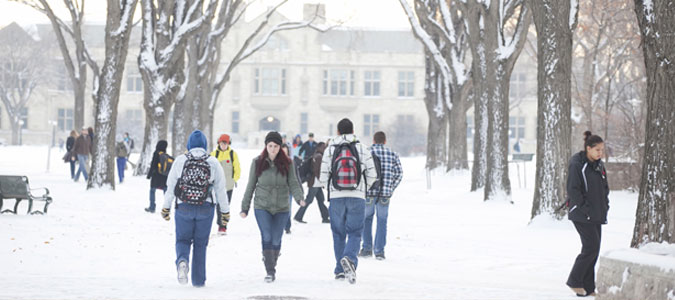Counting heads: 2012 census shows enrolment up 3.3%
Enrolment at the University of Saskatchewan for the 2012 fall term is up 3.3 per cent compared to last year, to 21,171 undergraduate and graduate students, and almost half of that increase can be attributed to changes to the nursing program.
By Kris Foster In a report to University Council Nov. 15 on census data collected Oct. 12, David Hannah, associate vice-president of student affairs, said that without the 236 additional nursing students and those in pre-nursing in the College of Arts and Science, the overall enrolment increase in 2012/13 would have been slightly lower than the previous year. In the past, first- and second-year students in the Nursing Education Program of Saskatchewan were enrolled at SIAST, and were only included in the U of S student census in their final years.
In a report to University Council Nov. 15 on census data collected Oct. 12, David Hannah, associate vice-president of student affairs, said that without the 236 additional nursing students and those in pre-nursing in the College of Arts and Science, the overall enrolment increase in 2012/13 would have been slightly lower than the previous year. In the past, first- and second-year students in the Nursing Education Program of Saskatchewan were enrolled at SIAST, and were only included in the U of S student census in their final years.
Of the total enrolment, there are 17,200 undergraduate students this fall (up 3.8 per cent), 3,023 grad students (up 4.4 per cent), 577 non-degree students and 371 post-graduate clinical students.
Hannah said additional strength in the undergrad number comes from the College of Arts and Science, which is up 327 students compared to fall 2011. Modest enrolment increases were recorded by all other colleges and schools with the exception of the Edwards School of Business, which is down 54 students, but Hannah stressed the census data covers only the fall term rather than fall and winter terms combined.
Looking at where students come from, Hannah said 77.8 per cent of all undergrads in direct-entry programs and open studies are from Saskatchewan, 11.2 per cent are from other provinces and seven per cent are from outside of Canada. Although the U of S remains "very heavily reliant on Saskatchewan students," a close look at first-time undergrads shows only a one per cent increase in the number of Saskatchewan students this year while first-time out-of province students increased by 27.5 per cent and international students were up 33.6 per cent.
An even further breakdown shows the number of new students from Alberta attending the U of S this fall jumped 31.2 per cent. Hannah said this reflects the success of not only a year-long recruitment effort but also changes to U of S admissions policy. This allowed for admission of Alberta students based on Grade 12 school-assigned marks rather than them having to wait for mandatory diploma exam marks.
Among international students overall, the largest group is from China (822, up 11.4 per cent) followed by India (144) and Nigeria (133).
Hannah spent some time discussing Aboriginal student numbers which showed an 8.9 per cent drop in self-declared undergrads this fall, and an eight per cent decline in Aboriginal graduate students. There was no change in the number of newly admitted Aboriginal students this year, he said, but the overall student count has dropped to 1,473, an indication to Hannah that "this may be a retention issue rather than a recruitment issue."
In fact, the first-to-second year retention rate for Aboriginal students in direct-entry programs is 58.2 per cent compared to 85.5 per cent for international students and 78.7 per cent overall. This, said Hannah, "is an area we need to work on."
One of the challenges facing census takers is that Aboriginal students must self declare their ancestry in order to be counted "and I know anecdotally that there are many Aboriginal students who think they've self-declared but haven't," said Hannah. Some students believe that enrolling in particular programs or even receiving certain scholarships counts as self-declaration, he said, and there is some data that is simply not being conveyed to the main student information system.
Hannah said staff in the Student and Enrolment Services Division is investigating ways of encouraging Aboriginal students to self declare to ensure the university has accurate statistics.
Data from the fall enrolment census that is available on the Information Strategy and Analytics website (usask.ca/isa) show the College of Arts and Science has the largest enrolment on campus with 8,794 students followed by the College of Engineering at 2,001 students and the Edwards School of Business at 2,000 (see related story below). The smallest is the School of Environment and Sustainability with 68 students.
Teaching activity measured in credit units is up 4.2 per cent this fall on campus, while off campus credit units are up 12.3 per cent. Hannah told Council members that according to Dan Pennock, acting vice-provost of teaching and learning, combining all of the students taking U of S programs off campus and through various distance education options would create the second largest college on campus.
A break down of students by gender shows that only four colleges or schools have more male students than female – dentistry, engineering, law and the school of public policy.

